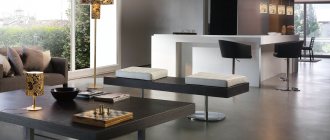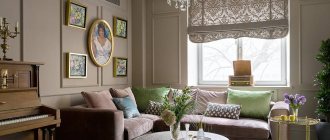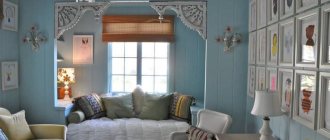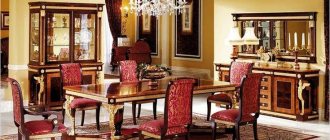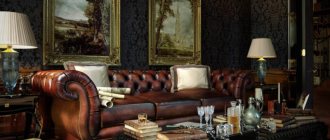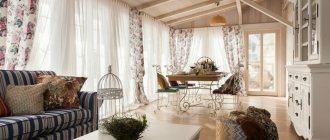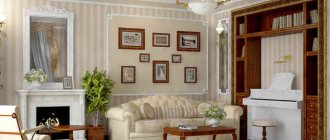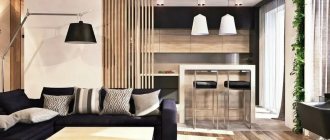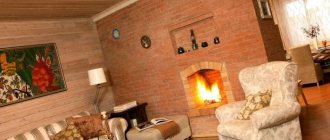Colonial style belongs to the group of classical styles. It received its name in honor of the colonists who, settling in foreign lands, not only brought with them their native traditions in interior design, but also borrowed customs from the local residents. In the direction, a balance was found between sophistication, luxury and laconicism, “native simplicity”. In fact, the colonial style in the interior is a combined eclectic potpourri, consisting of several ethnic branches. Each of them is characterized by certain features, but there are also general principles that unite these subgroups into one movement. Let's talk in this article about how to create a colonial interior in a city apartment or house with your own hands.
History of the origin of the style
A number of countries that in past centuries were located at the political “top of the world” could not boast of their own vast territories. Since their enrichment was largely due to the use of slave labor and the duping of the “backward” native population, rather than skillful management, they had to conquer more and more new territories. These countries primarily included Spain, Great Britain, France and the Ottoman Empire. After the discovery of “India” by Christopher Columbus, great prospects opened up for these states: two entire continents with rich lands and a population that was hung with gold, but did not know its real value. South and North America were “cut” into three parts, in which the native language of the colonialists is still spoken. The south went to Cortes and the bloody conquistadors, and the north was divided by the French and the British. The expansion and policy of colonialism obliged the metropolis to send military officers and governors who controlled the territories to their vassals. Since the period of residence could be tens of years, they moved with their families and settled down thoroughly. The interiors of the colonists' houses certainly contained features typical of their homeland, but at the same time local culture and features seeped into them, which made it possible to adapt to the unusual climate. The list of subject countries was not limited to mainland America. Great Britain at one time took under its wing part of Australia, New Zealand, Bangladesh, Seychelles, Mauritius, Barbados and a dozen other states that have now gained relative independence. France extended its “tentacles” to Syria, Morocco, Algeria, Chad, and Spain captured Manila, the Philippines, Guinea, part of the island of Taiwan and even the Sahara Desert. After the United States threw off the “yoke” of Mother Britain, the state followed in her footsteps and acquired Hawaii, the Philippines, Cuba, and Samoa. There was a colossal mixture of cultures, which subsequently resulted not in an unprepossessing potpourri with many ethnic elements, but in elegant, luxurious and original interiors.
The main directions of style and their distinctive features
Colonial style is an expensive pleasure that only people with above-average income can afford. The interiors use exclusively natural materials, which are now very expensive. General features of the direction include:
- Abundance of exotic vegetation. Colonization usually took place in tropical countries, which explains the use of “local” vines, ferns, and palm trees. Plants not only looked beautiful in homes, but also helped cool the hot air slightly.
- Wide floor-to-ceiling windows look more like doors. In colonial houses, openings were purposefully enlarged. To a large extent, this was done so that a pleasant draft appeared in the house.
- Use of natural wood and stone in exterior and interior decoration.
Although there are many substyles in the colonial direction, in our time only three of them have gained popularity:
- French;
- English;
- American.
The latter deserves special attention, since it is considered colonial “squared”, because before becoming a metropolis, the country itself was under the yoke of Britain for a long time. The direction is based on the classical style, which has expanded its boundaries. This was expressed in spacious (necessarily 2-3 storey) houses, where guests were greeted by a huge hall with a staircase. Solid wood prevailed in the materials, and the decor was made of forged metal. The English version of the style is an architectural and interior medley of Great Britain and India, which was its colony for a long time. The severity, stiffness and aristocracy of the British collided with the softness, openness and simplicity of the Indians. Classic interiors are complemented by “wild” trophies in the form of animal skins and heads on the walls, and Gothic features alternate with smooth, rounded lines and ornate patterns that used to decorate Hindu temples.
The French colonial style gave us the famous panoramic windows. In this direction, the clearest trace was left by mixing with Asian cultures. The interiors use silk wallpaper with thematic patterns, expensive porcelain, and metal decorative elements (boxes, vases).
Traditions in a modern interior
Literally every apartment in Portugal is equipped with a neat small kitchen. It looks really stylish and impressive both in a rural house on the outskirts and in a city apartment. This type of kitchenette is considered traditional, because the Portuguese spend little time cooking.
Homes in Portugal often try to preserve original details, including moldings, windows and blinds. This allows you to plunge into a special atmosphere. It looks really original.
As in other modern style trends, warm pastel shades predominate here. It is best to create an accent with a bright rug or even a bedspread. Natural textiles, wood and stone are the distinctive attributes of the Portuguese style.
Which countries will compete for Russian tourists in the summer of 2021
Two reasons why I always choose dirty vegetables at the supermarket rather than washed ones
The police told how to identify scammers and not lose capital
In bathrooms it is also common to stick to the main trend, so pastel shades come first here. Of course, Portuguese-style bathrooms are not complete without natural stone and wood finishes.
Despite the delicate shades, it is still customary to make bright accents. Slabs of pink and green marble as countertops are an excellent option for a discreet kitchen.
What do you think of this kitchen design option? In the picture you can see a modern interpretation of a traditional Portuguese farmhouse with a kitchen block that is painted blue in the style of Yves Klein. Making fashionable accents with blue, red and yellow is all in the spirit of the Portuguese.
How much did Valentine's Day cost Russians: survey results
“Electra”, in tune with our time: the premiere of the opera took place in St. Petersburg
A married couple rode a python on the hood of their car: photo
Finishing and choice of finishing materials
Among the finishing materials chosen are wood, stone and special clay bricks. If the owners prefer imitation (albeit an expensive one), then the interior will be a version of the colonial style adapted to modern realities. To create a classic interior in which the traditions of several nations have been assimilated, one cannot save money. The ceiling is plastered and decorated with wooden beams, the floor is covered with boards or tiled, and the walls can be covered with expensive fabric wallpaper. The option made of exquisite silk will suit the French style.
Spanish and Indian colonial style in the kitchen interior
Of all the listed variations, the Indian and Spanish versions are most often used in modern interiors. They look especially impressive in kitchen design.
To decorate a kitchen in the Spanish spirit, you must adhere to several rules:
- The walls, floor and ceiling are light, and dark colors are selected for doors, window frames and furniture.
- The doorways follow the shape of the arch.
- For the floor, it is better to choose tiles with Spanish motifs or natural wood.
- Ideally, there is a fireplace, wicker furniture and forging.
- Mandatory use of decor with the expressive flavor of Spain.
- Use only natural materials.
- So, for an apron the best finish would be natural stone.
- It is advisable to choose a kitchen set from expensive types of wood.
- There are straw roller shutters on the windows.
An Indian colonial style kitchen looks like this:
- The walls are painted in warm, natural tones.
- The ceilings have dark wooden beams.
- The floor is made in any of the shades of brown.
- Furniture – simple shapes and configurations.
- As a rule, it is quite low, with brightly colored seat upholstery.
- Accessories and textiles in the flavor of India - with rich colors and lush ornaments.
- The chandelier is forged, the windows are panoramic, often designed in the form of arches, like the doorways.
Furniture
The furniture uses materials that contrast in their characteristics: light wicker parts and massive objects made of natural wood. In the first case, reed, bamboo, palm branches and rattan are used as a base. Wicker armchairs, chairs and couches are covered with a heap of soft pillows. Such furniture is convenient because it can be easily moved to the garden if necessary. “Static” objects (wardrobes, beds, chests of drawers) are made by hand from solid wood. The facades are decorated with laconic carvings or wicker inserts.
To get a sample of classic furniture, you will have to order its production or go to expensive stores with designer products. A way to save money is to go to the so-called “flea market”, where you can buy old items. However, only Provence will appreciate their unprepossessing appearance. Well-preserved specimens without visible defects are suitable for the colonial style.
Colonial style in the interior: some design tips
- The modern construction market is replete with bright finishing materials. No matter how beautiful they are, their use to create a colonial interior is unacceptable. A neutral and light palette is appropriate here.
- Since the colonialists often had to move from one place to another, their furniture was multifunctional and as comfortable as possible. When creating a similar interior, you can purchase folding tables and chairs made of wood.
- If there is no need for folding furniture, it is recommended to use a table with crossed legs, a spacious spacious wardrobe, or a huge vintage chest.
- Since the colonial style is filled with exotic elements, wicker armchairs, a coffee table and chairs would be appropriate in the interior. The material for furniture can be bamboo, rattan and dark wood.
- It is recommended to use eclectic decorations, since this style combines the seemingly incongruous. The most unusual and unique trinkets are displayed in a prominent place to the envy of guests.
The only condition is that these elements must have historical or material value. Similar products can be purchased for literally pennies at flea markets. Often sellers do not know the true cost of a particular item.
Today, bamboo blinds and roller blinds are actively used to decorate windows, which are in no way inferior in color to their “ancestors”.
If the owners of the house are not against domestic animals, a cage with a large parrot will make the colonial interior more believable.
It would be nice if the animal theme could be seen in the decoration of the furniture. For example, a table with legs imitating lion paws will fit perfectly into a colonial setting. Even the outline of a sofa can resemble a huge animal lying down to rest.
It is quite difficult to find such pieces of furniture on sale, but any craftsman will be happy to make a massive cabinet to order, which seems to be held in the paws of huge gorillas in tailcoats.
Similar elements were necessarily present in the rooms of the colonialists of the past era. Most likely, such products were an unambiguous reminder to foreigners that they were not very welcome in the new lands.
Despite the fact that the colonial furnishings of a home are considered evidence of luxury and prosperity, its main purpose is still practicality. In a colorful style, simplicity, ultra-modernity and exoticism stand side by side.
In other words, the colonial style in the interior is a real art, capable of turning the most bizarre things into decorations.
The unusual surroundings do not interfere with the coziness and comfort of the residents. Here you are guaranteed complete rest and a creative mood, which is very necessary for gifted and developing individuals.
Color spectrum
The classic colonial style does not tolerate any flashy, bright accents. Since most houses were in a mercilessly hot climate, the basis of the color palette is white (black attracts light and heats up faster). In apartment options, indulgences in the form of pastel colors are allowed. Accent surfaces are painted in natural tones: brown, beige, burgundy, red, mustard, olive and dark blue. It is not recommended to combine more than three shades in one interior. The concept of the direction is such that the green spots of indoor plants will add brightness to the composition.
Lighting
Traditional lighting is complemented by devices with ethnic flavor. Original sconces and floor and table lamps are suitable for a classic chandelier. They are made of metal (bronze, iron, brass, copper), glass, leather and special rice paper. In this way, it will be possible to organically combine European traditions with elements of the “native” culture and provide the room with the necessary amount of light.
Accessories and decor
The decoration contains accessories from the animal world, as it occupied a special place in the cultures of the Aztecs, Indians, African tribes and islanders. Although paganism is considered a primitive religion, instead of a hierarchical pantheon of classical deities, it had its own laconic, natural “honor board” that was worshiped. If we are talking about elements native to Africa, then clay pots and plates, masks, figurines, textiles with ethnic patterns, paintings with a “sandy” landscape of the endless desert are suitable. To create an “American” flavor, they use dream catchers, roaches, and themed photos on the walls. Roughly processed skins, wicker chests, suitcases, and baskets can be used for upholstery. To convey a special interior mood, you can put a bundle of brushwood by the fireplace, which used to keep you warm on cold nights, and hang an old map of the world on the wall.
Don't forget about indoor plants. Ordinary dracaena, horvea, rapis or dallalia ferns, pteris will emphasize the originality of the situation and become an element that smoothes out the contrast between the two cultures.
Bedroom interior
A colonial style bedroom has one characteristic feature - a canopy over the bed. In tropical countries, it is installed not at all for beauty, but for the sake of protection from annoying insects. The bed itself is chosen either from solid wood with carved legs and “columns” under the canopy, or with elegant, forged elements. The walls are painted in a neutral shade of brown or a pastel tone. The floor is covered with boards and covered with carpet on top. The ceiling is simply plastered. On both sides of the double bed, bedside tables are installed symmetrically. Their surface is decorated with identical lamps. The “boudoir” area is replaced with a light table and a wicker chair. A box, suitcase or closed basket will become a colorful place to store things.
By the way, the textiles used for the canopy should have something in common with the fabric for the curtains. You can even sew both of these elements from the same material.
Main features and features of the colonial style
It is almost impossible to identify specific characteristics of this style. The thing is that travelers from different countries went to India and China, America and Africa, bringing from there completely different objects and views of the world. The colonial style is valuable for its diversity, its flexibility and ability to adapt to new cultures .
And yet we can identify several main features that are characteristic of all forms of this style. So, for example, space requirements. The room must be spacious , which is why such interiors are more often found in country houses than in apartments.
Another mandatory requirement is natural materials . Wood, stone, rattan and bamboo, metal - this is the main list of important style elements. Of course, linoleum and plastic in such an interior will look strange and ridiculous.
Color design of space in colonial style
The color scheme is also as close as possible to nature . Light shades of brown , beige and sand, cream and straw yellow - these tones usually act as the basis for the interior. They are shaded by dark brown, ocher, chocolate and terracotta . But bright colors are found very rarely and only in accessories.
Colonial style furniture
The classic setting is rattan tables and chairs . Natural materials and African tribal techniques guarantee full compliance with style. But not everyone likes this situation. Lovers of traditional upholstered furniture can enjoy low sofas and armchairs upholstered in subdued colors . Such interior items should radiate luxury and look massive and antique. It is best to choose models with brocade, leather or suede upholstery , as well as elegant wooden inserts. It is worth noting that the types of wood also differ from the usual ones: for the colonial style, Asian walnut, teak and mahogany are preferred.
Lighting
Be sure to pay due attention to lighting. It is recommended to choose rooms with large windows and natural light , but it is also worth considering a multi-level lighting system. To emphasize the European basis of the interior, you can use a massive chandelier. But it will be complemented by stylish and unusual sconces with ethnic motifs.
Accents and decor
A large number of small and large figurines , trinkets and various souvenirs of the same style is an ideal option for interior decoration. Shaman masks , mirrors in carved frames, figurines of people and animals - this list is very long. Don’t forget about living plants, which will highlight the colonial style in the interior.
Living room interior
The central decoration of the colonial living room will be a classic fireplace. It is made of dark stone, which favorably emphasizes the light walnut finish of the walls. By the way, this surface is simply plastered or painted, since accessories and textiles will become accents in the interior composition. Classic paintings in baguette frames and luxurious mirrors are hung on the walls. The joint between them and the ceiling is decorated with a neat fillet with stucco elements. In addition to the central crystal chandelier, candlesticks are installed around the perimeter of the room on the mantelpiece and tabletops. If the dimensions of the room allow, then there are two recreation areas in it. The first is a composition of a massive sofa and a pair of armchairs around a coffee table. The best intellectual activity on this site will be playing chess. The second furniture group consists of a pair of wicker armchairs or chairs. They are placed around the second coffee table by the window. The place is ideal for reading or drinking tea over a measured conversation. The windows are covered with thick curtains with ethnic patterns. The floors are covered with short-pile carpets. We must not forget about indoor plants, the pots of which are evenly distributed throughout the room.
Kitchen interier
To decorate the kitchen, use a classic massive set of brown or unusual olive color. Its facades are decorated with metal handles. The ceiling is plastered and decorated along the joints with the walls with stucco. In rare cases, the surface is covered with boards and decorated with roughly processed beams. An original decorative element will be a chandelier, which is equipped with special hooks along the radius of the entire lampshade. Ladles and pans are subsequently hung on them. Ethnic flavor in the kitchen is manifested in small details. The apron is decorated with stone. Clay pots, jugs, vases, plates and other “native” utensils are hidden on open shelves and behind the glass doors of a classic set. The interior is also complemented with wicker baskets, which can generally create a single storage system, where traditional drawers are replaced with a “lightweight” version made of reed or rattan. An island layout with a table for preparing and quickly eating food in the middle of the room is considered a mandatory element even in the smallest kitchens. Of course, colonial houses had spacious dining rooms, but the servants usually ate separately from the owners. It can be decorated with forged elements, covered with a tablecloth and decorated with a bowl of fruit.
Bathroom
The colonial-style bathroom is decorated with tiles. If we are talking about the English direction, then a “checkerboard” of terracotta-colored tiles and a shade of wet asphalt on the walls will look organic. The floor is finished with light ceramic tiles laid in a herringbone pattern with fasteners. Bathroom furniture is chosen from wood (specially treated) in light brown shades. The wall above the sink is decorated with a rectangular mirror with a simple frame. Simple lamps are placed on both sides. A traditional bathtub is decorated with brass and stands on graceful legs, as in all classic interiors. Clay vessels, dishes, and miniature elephants inlaid with stones are placed on the countertop near the sink.
Modern colonial style
Original and extraordinary, ethnic and steeped in tradition, based on high-quality carved wooden and wicker furniture combined with exotic decorative motifs, the colonial style in the interior is the result of the interpenetration of very different cultures. The synthesis of European traditions and practicality and oriental luxury and exoticism can make a colonial-style house an object of admiration even among a sophisticated audience.
The main features of the style are:
- scope in everything - high ceilings, wide windows, large spacious rooms;
- closeness to nature - natural wooden furniture and decorations, hand-made carpets and mats in oriental style, plenty of natural light;
- the use of colorful colors and shades - brown, burgundy, muted orange and yellow, red, green, black and white;
- the presence of ethnic accessories - bronze figurines, velvet pillows, embroidered with patterns, floor lamps and lampshades made of thick linen and silk, carved panels of dark wood;
- “animal” motifs - lion paws instead of traditional furniture legs, chair backs decorated with elephants and other talismans and amulets that have a sacred meaning in the East;
- living vegetation – palm trees, ferns, bamboo, exotic flowers in large outdoor flowerpots.
Living room in colonial style
Being the main and most spacious room of the house, the hall successfully accommodates all the listed design features. As a result, the colonial style in the interior of the living room is fully revealed. The calmness and confidence that such an interior breathes encourages communication, puts you in a friendly mood and reveals the character of the owner of the house. Guests have the opportunity to view unique souvenirs from distant exotic countries and unusual handmade items.
To embody the colonial style in the interior of the hall, it is preferable to use calm pastel colors, and to dilute the atmosphere, you can complement it with richly colored textiles - curtains and carpets. A similar pattern looks very advantageous on all textile surfaces, including furniture upholstery. This unity of motives will help hold the composition together.
Colonial style in the bedroom interior
If you are an adventure lover and a conqueror of different distant countries, a colonial-style bedroom will definitely suit you. A wide and luxurious bed will definitely make your rest and night's sleep incredibly comfortable. Wood, as the main material, is best suited for the bedroom, being environmentally friendly and completely safe. You are free to choose pastel colors or authentic combinations of white and blue, red and gold to decorate your bedroom. The main thing is that you feel comfortable in such an environment.
In addition to a massive wooden bed, the bedroom must also have other furniture similar to it: a large three-leaf wardrobe, a chest of drawers with many drawers, a chest, a carved dressing table. Light natural textiles, a comfortable sitting area with an armchair or sofa, high ceilings and lots of light will make the bedroom interior romantic and pleasant.
Colonial style kitchen
The main features of such a kitchen are simplicity, conciseness and functionality. In the open space of a large room, you can place a chic kitchen set with an island in the middle, and hang kitchen utensils above it. If possible, it is advisable to equip the room with a large brick oven or at least an imitation of it. This detail will become the main highlight of the room.
The colonial interior in the kitchen is created using light shades of brown combined with beige and yellow. The addition is dark wood and natural stone. This interior looks noble, calming, and very homely. He does not accept bright accents; everything here must be kept in a calm and harmonious manner. The floor is made of practical stone or tiles, the furniture fronts are exclusively wooden, the table and chairs are massive and also wooden.
Entrance hall in colonial style
As in other rooms, the colonial style in the hallway interior is characterized by calm pastel colors, the presence of furniture made of wood, rattan, bamboo, the presence of many exotic accessories such as decorative panels on the wall, African masks on the chest of drawers, chests and wicker baskets as storage places. The role of flooring is often played by porcelain tiles. To set off light walls, you can make the floor darker.
What distinguishes the American colonial style in the interior is a relatively small number of accessories and decor, a minimum of furniture and simplicity of decoration. As for color, natural colors are also welcome here, various shades of soil - brown, beige, green. You can place a large mirror on the wall in the hallway, or it can be a large mirrored wardrobe door.
Colonial style office
By embodying the English colonial style in your work space, you can safely use the heraldic symbols of Great Britain as one of the main maritime powers of the colonial era. The symbols can be placed above the chair on a snow-white wall - such an office will resemble the workplace of an important English official. A similar use of the symbols of India and other powers would look no less pompous.
Another option for a study using the colonial style in its interior is a functional and laconic room, where nothing distracts from work, and the style is reminiscent of massive teak furniture with exquisite decor, plant motifs embodied in paintings, and a table in the form of a classic colonial bureau. And for breaks at work and a comfortable rest, be sure to make sure there is a soft sofa here.
Colonial style in the bathroom
When embodying the colonial style in the interior of a house or apartment, there is no way to bypass such an important room as the bathroom. If it is combined, then there should be no clear boundaries between the toilet and the bathroom - this is a feature of the style. All transitions should be smoothed out as much as possible. To softly divide the space, columns, multi-level ceilings and floors, niches, translucent screens and partitions are used.
A colonial-style bathroom should be light and spacious, filled with all the means for civilized body care. This includes a shower cabin, a wide bathtub, a washbasin, many shelves and cabinets for bathroom accessories, mirrors, and high-quality lighting. In a word, everything that will help you take full care of yourself.
Studio apartment interior
Colonial style is ideal for decorating a studio. If you use the French direction, you can zone a large room with a classic interior using mobile screens typical of Asian interiors. The accent wall is covered with fabric wallpaper, and the rest of the surface is plastered. By the way, it is better to keep textiles away from the “kitchen” area. You can close the bedroom with curtains and add a couple of pots with plants to the zoning, which are symmetrically placed on the floor. Alternatively, one wall can be decorated with a series of naturalist paintings or Indian paintings or African ritual elements.
How did the colonial style appear in the interior?
The colonial style originated in the era of large-scale land development by Europeans. The colonialists, who came to countries that were exotic for them, did not want to live in the not very fashionable and fragile huts of the local residents.
Therefore, they preferred to settle in the luxurious and comfortable mansions that were familiar to them. But gradually their houses acquired the flavor of colonized lands.
African, Indian, and Asian motifs became part of the colonial style in the home interiors of the Spaniards, English, French and Portuguese. This is how a unique direction in interior design emerged. At its core, it is a mixture of the European classical tradition with the exoticism of the East.

